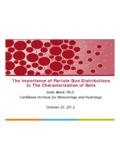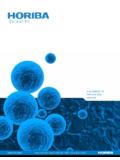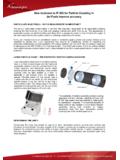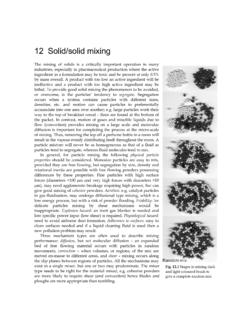Transcription of Method Development and Validation for Particle Size and ...
1 Method Development and Validation for Particle size and Shape Measurements Ulf Will n Divisional Product Manager Analytical Imaging Systems Malvern Instruments Ltd, Malvern, UK. FDA guidance: when should Particle size be measured? International Conference on Harmonization;. Guidance on Q6A Specifications: Test Procedures and Acceptance Criteria for New Drug Substances and New Drug Products: Chemical Substances*. New Drug Substances (b) Particle size : For some new drug substances intended for use in solid or suspension drug products, Particle size can have a significant effect on dissolution rates, bioavailability, and/or stability.
2 In such instances, testing for Particle size distribution should be carried out using an appropriate procedure, and acceptance criteria should be provided. Decision Tree #3 provides additional guidance on when Particle size testing should be considered. *Federal Register/Vol. 65, , Friday December 29, 2000/ Notices p. 83041-83054. FDA guidance: when should Particle size be measured? Yes to any? Yes Critical to Solid dosage form dissolution, or liquid with Set acceptance criterion solubility, undissolved drug? bioavailability? No No drug substance Critical to drug Particle size criterion product required for solution processability?
3 Dosage forms Critical to product stability? No to all? Critical to product No acceptance criterion content necessary uniformity? Comparing techniques: assessing different technologies Comparing techniques: assessing different technologies Better Characterisation - size and Shape % %. size Only size size Large Primary particles Aggregates (Low circularity). size and Circularity Circularity Shape size size Convexity - Dissolution behaviour Lower convexity higher surface area Increased surface area faster dissolution Laser Diffraction & Optical Imaging Optical Microscopy (USP <776>, ISO 13322-1).
4 Laser Diffraction (USP <429> , EP , ISO13320-1). What information should be included in the Particle size specification? ICH Q6A Guidance Analytical Procedure (system suitability, sampling, dispersion,, etc.). Method Validation (precision, ruggedness, dispersion stability, robustness, etc.). Acceptance Criteria (upper and lower limits). FDA guidance: Analytical Procedures and methods Validation *. The normal concepts of Validation may differ for Particle size methodologies as compared to other analytical methodologies such as HPLC.. the system should be calibrated according to the manufacturers and/or the laboratory's specification, as appropriate.
5 The methods Validation usually involves evaluation of intermediate precision and robustness.. Assurance should be provided that the data generated are reproducible and control the product's quality.. *Section F: Methodologies relating to Particle size analysis;. Professor Harold Heywood (1905-1971). However, it must be realised that Particle size analysis is not an objective in itself but is a means to an end, the end being the correlation of powder properties with some process of manufacture, usage or preparation . H Heywood Proc. 1st Particle size Anal.
6 Conf. September 1966. p 355 - 359 (Heffer). FDA guidance: why should accuracy not be assessed? Accuracy can be difficult to define for size analysis Easy for spherical particles For non-spherical particles all sizing techniques give different answers. For laser diffraction: You do need to verify the system See ISO13320 / USP<429> / EP for details Microscopy is the most important referee Method Method Development and Validation : PASG. definition of sample preparation*. The pre-treatment and the presentation of the sample to the measuring technique in a meaningful manner.
7 Need to consider How the primary sample is obtained How the material is dispersed Wet or dry dispersion? Dispersed or agglomerated state? *See Bell, R., Dennis, A., Henriksen, B., North, N., and Sherwood, J., (1999) Position Paper on Particle Sizing: Sample Preparation, Method Validation and Data Presentation Pharmaceutical Technology Europe, November Sample presentation: what do we need to consider? Novices in the size measurement field must understand that most errors in size measurement arise through poor sampling and dispersion and not through instrument inadequacies.
8 T. Allen, Advances in Ceramics, Vol 21: Ceramic Powder Science, page 721, The American Ceramic Society Inc. (1987). Dr. Henk Merkus Quality Assurance in Particle size Measurement from Improving Standards in Particle size Distribution Measurement, February 17- 19, 1997, at the Engineering Research Centre for Particle Science and Technology Sampling: Particle segregation Sampling: typical errors associated with different techniques Method Estimated max error (%). Cone & Quartering Scoop Sampling Table Sampling Chute Riffler Spinning Riffler From: T.
9 Allen Particle size Measurement Chapman and Hall 4th Edition 1993 Page 39. Figures based on a 60:40 sand mixture. Sampling: using a spinning riffler Sample stream Sample pots on from a vibrating a revolving tray hopper Sampling: riffled sample measurements 350. 300. RSDs 250 Dv10. Dv50 Dv10: size / Microns Dv90. 200 Dv50: Dv90: 150. 100. 50. 0. 0 2 4 6 8 10 12 14 16 18 20. Measurement Number Sampling: obtaining unbiased samples from slurry systems Stirrer Isokinetic sampling probe Speed of sample rise matches sample extraction velocity Flow baffles Sample preparation: product form Sample presentation: force of adhesion / cohesion between particles 107.
10 106. 105. Force of Adhesion / Gravitational Force 104 Adhesion 103. 102. 101. 100. 10-1. 10-2. 10-3. 10-4. 10-5. 1 10 100 1000 10000. Particle size / Microns From: Aerosol Science, Ed. C N Davies, Academic Press, London and New York, 1966. Sample presentation: affect of sonication on the Particle size reported by laser diffraction Initial Dispersion (Pump and Stirrer) Ultrasound Applied Ultrasound Off 250. Dv10. Particle size / Microns 200 Dv50. Dv90. 150. 100. 50. 0. 0 5 10 15 20. Measurement Number Using image analysis as a referee Method After inappropriate level of sonication broken particles With reduced level of sonication no broken particles Using image analysis as a referee Method Pharmaceutical dispersed in cyclohexane With no surfactant a high level of agglomeration is observed Wide size and shape distributions Images show high degree of agglomeration Using image analysis as a referee Method Same sample but with addition of lecithin Narrower and smoother size and shape distributions Images confirm individual








